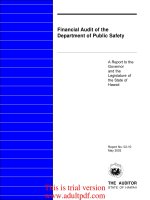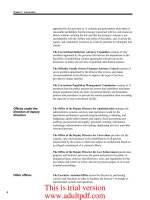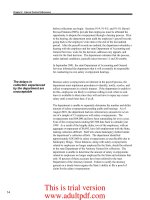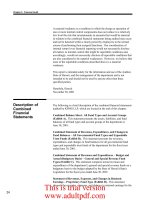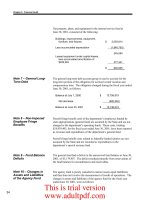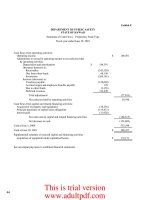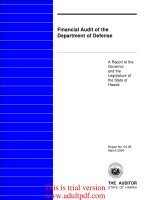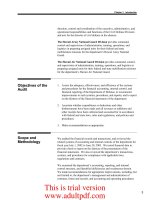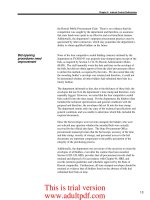Report to Congressional Committees and Subcommittees FINANCIAL AUDIT District of Columbia Highway Trust Fund’s 1996 Financial Statements_part2 docx
Bạn đang xem bản rút gọn của tài liệu. Xem và tải ngay bản đầy đủ của tài liệu tại đây (56.67 KB, 10 trang )
B-278524
work. Specifically, the District did not provide evidence for $3.7 million
(36 percent of the $10.3 million) in capital appropriated expenditures and
the related liability to the Capital Operating account.
14
Thus, the financial
statements may be unreliable.
• Material weaknesses in internal controls resulted in ineffective controls
over (1) safeguarding assets, specifically revenue cash receipts, and/or the
related accounts receivable, from material loss and (2) assuring that there
were no material misstatements in amounts reported in the financial
statements, specifically capital appropriated expenditures, the liability to
the Capital Operating account, and revenue. In addition, we identified a
material weakness in computer system general controls over (1) physical
and logical security, (2) segregation of duties, and (3) service continuity.
• We are unable to report on compliance with laws and regulations because
the District’s lack of adequate documentation, which is discussed later in
this report, limited the scope of our work.
• Also because of the lack of adequate documentation, we are unable to give
an opinion on whether the underlying assumptions and methodology used
to develop the Fund’s 5-year forecasted statements provide a reasonable
basis for such statements or whether the statements are presented in
conformity with guidelines established by the American Institute of
Certified Public Accountants (
AICPA).
The following sections provide additional detail concerning our
conclusions and the scope of our efforts.
Disclaimer of Opinion
on Financial
Statements
We are unable to give an opinion on the financial statements of the Fund
for the 14-month period ended September 30, 1996, because the District
could not provide detailed supporting documentation for $3.7 million (36
percent of the $10.3 million) in capital appropriated expenditures and
24 percent of the related liability to the Capital Operating account. As a
result, we are unable to determine if the financial statements’ presentation
of the capital appropriated expenditures and the related liability to the
Capital Operating account is reliable. A more detailed discussion of the
documentation problem is provided in the next section.
Statement on Internal
Controls
We gained an understanding of internal controls designed to
14
Once non-FHWA federal aid or local highway project costs are paid by the District, the amount to be
reimbursed by the Fund is charged to capital appropriated expenditures and a liability to the District’s
Capital Operating account is established.
GAO/AIMD-98-30 D.C. Highway Trust FundPage 9
This is trial version
www.adultpdf.com
B-278524
• safeguard assets against loss from unauthorized acquisition, use, or
disposition;
• assure the execution of transactions in accordance with management’s
authority and with selected provisions of those laws and regulations that
have a direct and material effect on the Fund’s financial statements; and
• properly record, process, and summarize transactions to permit the
preparation of reliable financial statements and to maintain accountability
for assets.
The purpose of our work was to determine our procedures for auditing the
financial statements, not to express an opinion on internal controls.
However, internal controls were ineffective as a result of material
weaknesses found over (1) safeguarding assets, specifically revenue cash
receipts and the related accounts receivable, from material loss and
(2) assuring that there were no material misstatements in amounts
reported in the financial statements, specifically capital appropriated
expenditures, the liability to the Capital Operating account, and revenue.
In addition, we identified a material weakness in computer system general
controls over (1) physical and logical security, (2) segregation of duties,
and (3) service continuity.
A material weakness is a condition in which the design or operation of one
or more of the internal control elements does not reduce to a relatively
low level the risk that errors or irregularities in amounts that would be
material to the financial statements may occur and not be detected
promptly by employees in the normal course of performing their duties.
Our internal control work would not necessarily disclose all material
weaknesses. The following deficiencies identified in internal controls may
adversely affect the quality of data on which management decisions are
based. Unaudited information reported by the Fund, including the 5-year
forecasted statements, may also contain misstatements resulting from
these deficiencies.
Capital Appropriated
Expenditures
The District did not provide adequate documentation to support their
$3.4 million year-end closing adjustment
15
and $266,000 for six
15
At year-end, an adjustment was made to match FHWA revenues with federal aid capital appropriated
expenditures. The net amount of federal aid capital appropriated expenditures that exceed FHWA
reimbursable amounts is charged to the Fund’s capital appropriated expenditure account. This is
needed since federal capital appropriated expenditures are limited to amounts billable to FHWA, and
excess amounts are to be reimbursed by the Fund.
GAO/AIMD-98-30 D.C. Highway Trust FundPage 10
This is trial version
www.adultpdf.com
B-278524
intra-District voucher payments
16
charged to capital appropriated
expenditures. Without detailed supporting documentation, the validity of
$3.7 million (36 percent of the $10.3 million) in capital appropriated
expenditures, as well as the related liability to the Capital Operating
account, could not be determined. Even though procedures for
maintaining documentation for all payments existed,
DPW officials stated
that the support for the six intra-District voucher payments could not be
located.
The District does not have procedures for maintaining detail-level support
for the year-end closing adjustment and officials stated that the process
for going back to trace these costs back to the detailed transaction level is
cumbersome. As a result of our attempt to audit the Fund,
DPW
acknowledged the need to establish procedures to ensure that more
detailed transaction information is available to support future audits of the
Fund.
In addition, the District did not seek
FHWA reimbursement for construction
engineering (
CE) cost overruns
17
of $2.6 million included in the above
mentioned year-end closing adjustment.
CE cost overruns of up to 15
percent of the annual aggregate federal aid project construction costs are
eligible for
FHWA reimbursement. Any amounts above the 15 percent
reimbursement ceiling would be charged to the Fund. However, the
District only sought reimbursement for budgeted costs and did not seek
FHWA reimbursement for the CE cost overruns of up to the above 15
percent. On July 8, 1997,
FHWA notified the District that it could seek
reimbursement of the $2.6 million of
CE cost overruns pursuant to section
106 (c) of title 23, United States Code, and its implementing regulation in
23 C.F.R. 140.205. Since no
CE cost overruns were submitted for FHWA
reimbursement, the District charged the Fund CE costs that could be
reimbursable by
FHWA. Without adequate documentation as to the validity
of the $2.6 million of the above adjustment, the amounts eligible for
FHWA
reimbursement or chargeable to the Fund cannot be determined. This
occurred because District procedures did not address
CE cost overruns,
and District officials were unaware of the
FHWA criteria for the
reimbursement of
CE cost overruns.
16
An internal voucher is used to charge a particular District fund, for the services rendered, that were
paid by another fund. For example, the General Fund is used to pay all District salaries and an
intra-District voucher is used to charge the Fund for hours that District employees actually worked on
federal-aid projects.
17
CE cost overruns are individual project amounts in excess of budgeted amounts.
GAO/AIMD-98-30 D.C. Highway Trust FundPage 11
This is trial version
www.adultpdf.com
B-278524
We also found that the District lacked basic internal control procedures to
ensure the proper segregation of duties related to cash disbursements.
One
DPW person had overall responsibility for processing and approving
costs associated with the Fund. We found that 114 of the 142 expenditure
journal entry transactions that we tested were prepared, authorized, and
recorded into the District’s Financial Management System (
FMS) by the
same person without independent reviews or approvals. The lack of
supervisory review increases the possibility of unauthorized or ineligible
costs and errors not being corrected for amounts recorded and paid.
As a result of the lack of documentation and failure to segregate duties
related to cash disbursements, the risk of misappropriation, errors, and
irregularities related to capital appropriated expenditures is increased.
Revenue
Weaknesses in revenue procedures resulted in motor fuel tax payments
that were not recognized in the proper accounting period and deposited in
a timely manner. We found that revenue was recorded when received, not
when receipts were both measurable and available,
18
and deposits were
made an average of 14 days after receipt, resulting in over $3.6 million of
revenue that was recognized in the wrong accounting period and
approximately $74,500 in potential lost interest income.
The following revenue recognition problems that we identified for the
14-month period were subsequently corrected by the District:
• Motor fuel tax revenue for September 1996 totaling $2.5 million was
received in October 1996 and the District incorrectly recorded it in fiscal
year 1997 instead of fiscal year 1996. Fuel tax receipts received by the due
date, the 25th day of the following month, and deposited within another 14
days were incorrectly recorded as revenue on the deposit date instead of
the tax due date. Since the tax receipts were both measurable and
available as of September 30, 1996, the District should have recorded this
amount as part of the Fund’s fiscal year 1996 revenue. The failure to do so
reduced assurance that revenue was reflected in the proper period and
recognized under the modified accrual basis. The District adjusted its
records and included the $2.5 million as part of the fiscal year 1996
revenue.
18
The District uses the modified accrual basis of accounting for the Fund. Under this basis, the District
recognizes revenues when they become both measurable and available—the District considers
revenue receipts available if they are collected within 60 days from the tax due date. For example, an
amount reported as due to the Fund as of September 30, 1996, should be treated as fiscal year 1996
revenue if the amount was actually collected by November 29, 1996.
GAO/AIMD-98-30 D.C. Highway Trust FundPage 12
This is trial version
www.adultpdf.com
B-278524
• The District deposited and recorded $1.1 million of July 1996 motor fuel
tax revenue from a wholesaler as a fiscal year 1997 transaction in February
1997. This wholesaler typically delivered checks to a mailing service for
forwarding to the cognizant taxing authority. The wholesaler had
confirmation of receipt dated August 26, 1996, by the mailing service, but
there was no evidence that the District had received that check. The
wholesaler stopped payment on the original check on January 17, 1997,
and reissued a replacement check on January 31, 1997. To reflect the
proper recognition of this missing check, the District adjusted its records
and included the $1.1 million as a fiscal year 1996 revenue transaction.
The delays caused by untimely revenue processing and depositing resulted
in the loss of interest income. These delays also increased the risk that
cash and revenue were exposed to loss from misappropriation, error, and
irregularities. We found that the District did not have procedures for
depositing receipts. It took the District an average of 14 days from the time
monthly fuel tax payments were received with tax returns until they were
logged, endorsed, and deposited into the bank. One payment was not
deposited for 5 months. Sound cash management practices require cash
receipts to be deposited daily, which is consistent with U.S. Treasury
requirements for all federal agencies. According to our analysis, revenue
processing delays (1) resulted in approximately $74,500 in potential lost
interest income (calculated using an average rate of 5 percent for
short-term Treasury bills in which the District invests any excess cash) for
the audit period and (2) could have contributed to the missing wholesaler
check for July 1996 that was not received until February 1997.
As the District considers options to upgrade its internal receipt processing
to establish adequate controls and prudent cash management practices, a
lockbox system
19
is an alternative for reducing processing delays and
untimely deposits. The District currently uses a lockbox for the prompt
deposit of tax collections for the Sports Arena to reduce the risk of lost
funds, increase interest income, and improve the timeliness of deposits.
Under a lockbox system, customer payments to the post office box are
accessible only to the bank, and cash flow is improved. District employees
have no contact with cash remittances deposited directly into a lockbox,
and the risk of mishandling or misappropriation is significantly reduced.
Even though the banks charge a monthly fee for such services, those costs
could be more than offset by the additional interest earned on investments
promptly deposited.
19
A lockbox system is a banking service under which the bank assumes responsibility for receiving,
examining, and processing incoming receipts from a customer.
GAO/AIMD-98-30 D.C. Highway Trust FundPage 13
This is trial version
www.adultpdf.com
B-278524
In addition to these revenue recognition problems, the following issues
significantly reduced the effectiveness of controls over revenue and cash
receipts, and further increased the risk of cash manipulation:
• The District does not know whether all motor fuel taxes are collected
since it relies on an honor (self-assessment) system. According to the
District’s Office of Tax and Revenue (
OTR) officials, the last verification of
motor fuel taxes occurred approximately 7 years ago and revealed that
construction companies underreported the number of gallons consumed
within the District. As a result of following the honor system (given the
problems identified from the last verification, as well as the absence of
procedures to verify fuel used and the related taxes), the District cannot
determine whether wholesalers and construction, bus, and other
companies have reflected the total actual quantity of fuel sold to retailers
and consumed, respectively. Accordingly, the possibility exists that some
wholesalers and/or construction, bus, or other companies do not pay
either motor fuel taxes or all amounts due to the District.
• The District does not have procedures to ensure the segregation of duties
related to recordkeeping and the physical handling of cash receipts. One
OTR employee was the sole person responsible for processing tax returns
and the related remittances. The person received and reviewed the tax
returns, recorded all deposits on a spreadsheet (log), endorsed checks,
and prepared standard deposit tickets and Revenue Cash Receipt forms.
The person also hand delivered the checks to the District’s cashier for
deposit. There was no evidence of supervisory review of the cash receipt
process, and no other staff person was assigned or trained to prevent
further delays or processing errors when this person was absent or ill.
Computer System General
Controls
DPW relies on computerized information systems to process and account
for the Fund’s financial activities. General controls over the systems are
intended to prevent or detect unauthorized access and intentional or
inadvertent unauthorized modifications to the data and related computer
programs. Our audit revealed that general controls over the systems were
ineffective.
DPW’s Office of Information Systems (OIS) operates a local area network
(
LAN) with 70 servers
20
located at two data centers. Four servers on the LAN
are used to process the five financial applications that relate to federal aid
and local capital projects, including the Fund. The applications that
20
A file (or network) server is a high-speed computer in a network that stores program and data files
shared by users on a network.
GAO/AIMD-98-30 D.C. Highway Trust FundPage 14
This is trial version
www.adultpdf.com
B-278524
involve the Fund include the (1) Overhead Distribution System,
(2) Federal Aid Billing Systems (
FABS), (3) Labor Acquisition and
Distribution System (
LADS), and (4) Vehicle Usage System. For the most
part, these applications obtain data from
FMS (the central system and the
original point of entry for capital project transactions) or distribute job
cost data to the capital projects in
FMS. For example, FABS is a reporting
system that obtains information from
FMS and organizes the data in a
different format for billing to
FHWA. In addition, LADS and the Vehicle Usage
System distribute payroll and vehicle usage costs, respectively, to the
appropriate capital project in
FMS. The various users and multiple
application systems are part of a decentralized computer environment
where strong controls are vital.
The
OIS computer environment lacked basic system controls to prevent or
detect unauthorized access and intentional or inadvertent unauthorized
modifications to the data and related computer programs. We identified
the following significant weaknesses in the controls over (1) physical and
logical security (access to facilities, systems, and data), (2) segregation of
duties, and (3) service continuity:
• Security over the system and its data was not adequate to protect against
unauthorized access to sensitive systems for personal gain or destructive
purposes. Physical access to both data centers was not controlled. For
example, the door remained unlocked at one data center, and backup files
were not protected at the other data center. In addition, logical access to
computer and application systems was not monitored. For example,
current security risks were not analyzed, access to security functions was
not restricted, security access files were not maintained, and
LAN
modifications were not adequately controlled, resulting in updates that
were not uniform across the four servers. Further, written security policies
and procedures had not been formalized and distributed. Without
assurance that security procedures are adequate, the integrity and
reliability of financial data face a greater risk of being compromised.
• DPW did not adequately practice segregation of duties. Seven employees
with supervisory access had control over the entire computer environment
(including data files, production software programs, systems software, and
utilities). Generally, no one person should have complete access to the
entire computer environment without supervisory review by another
person. In addition, another employee performed all phases of application
modifications. The lack of segregation of duties provides the opportunity
for controls to be circumvented, which can result in unauthorized access
and changes to systems and software applications.
GAO/AIMD-98-30 D.C. Highway Trust FundPage 15
This is trial version
www.adultpdf.com
B-278524
• Service continuity is at risk since there was no current written and tested
disaster recovery plan. Contingency disaster plans are needed to ensure
that financial and other management information can be maintained if
data processing operations are unexpectedly interrupted due to a
disruption of electrical power or other events that might cause operations
to halt. An interruption of computer services can significantly reduce the
District’s ability to meet users’ needs for products and services and
maintain control over District operations.
In addition, a Year 2000 program
21
evaluation and conversion plan had not
been established. District systems are time dependent with databases and
programs created to store and process the year as a 2-digit field (for
example, 1997 as “97”). Without promptly assessing concerns and
strategies for addressing this issue, the advent of the year 2000 will pose
significant problems, and processing codes, interfaces, and multiple
processing environments may not operate.
Compliance With
Laws and Regulations
We were unable to test the laws and regulations we considered necessary;
accordingly, we are unable to report on the Fund’s compliance with laws
and regulations. The lack of adequate documentation limited the scope of
our work for 36 percent of the capital appropriated expenditures. For
example, as discussed earlier, the District could not provide detailed
support for the year-end closing adjustment for $3.4 million in federal aid
project costs that were charged to the Fund. Thus, we could not examine
supporting documentation to determine whether the transactions
recorded in the Fund’s accounting records complied with laws and
regulations deemed significant to the financial statements.
Disclaimer on 5-Year
Forecasted
Statements
The act requires the District to prepare 5-year forecasted statements of the
Fund’s expected conditions and operations. These forecasts are required
to determine the District’s ability to meet future local matching
requirements under the federal highway program for capital improvements
to the District’s transportation system. In June 1997, the District prepared
the Transportation Program’s Capital Improvement Plan for fiscal years
1998 through 2003 (the 5-year forecasts) and submitted it to the Congress
for review and approval.
21
A Year 2000 program addresses the problem caused by the way dates are recorded and used in many
computer systems. Many systems use two digits to represent the year. As a result of this ambiguity,
system or application programs that use dates to perform calculations, comparisons, or sorting may
generate incorrect results when working with the years after 1999. Systems that are Year 2000
compliant do not have this date problem.
GAO/AIMD-98-30 D.C. Highway Trust FundPage 16
This is trial version
www.adultpdf.com
B-278524
We attempted to examine the Fund’s 5-year forecasted statements that the
District prepared and submitted to the Congress. We could not complete
our examination because the District did not have adequate
documentation related to the preparation and presentation of the
forecasted statements. For example, the District lacked adequate
documentation to support the underlying assumptions and the
methodology used to develop the forecasts. As a result, we are unable to
and do not give an opinion on whether the underlying assumptions and
methodology used to develop the forecasts provide a reasonable basis for
the Fund’s 5-year forecasted statements or whether such statements are
presented in conformity with guidelines for presentation of a forecast
established by the
AICPA. And since significant differences between the
1996 base year forecasts and the reported expenditures were not
reconciled, we did not include the 5-year forecasted statements in this
report.
The
AICPA Forecast/Projection Guide establishes presentation and
disclosure requirements, and accounting and auditing guides published by
the
AICPA have been identified as sources for determining generally
accepted accounting principles for prospective financial statements.
Under the guide, the forecast process should consist of (1) a formal
system for preparing forecasted statements, (2) performance of a work
program that outlines the steps followed in preparing the statements, or
(3) documented procedures, methods, and practices used in preparing the
statements. It also states that good faith, appropriate care, accounting
principles, best information, consistency of information, key factors,
appropriate assumptions, assumption sensitivity, documentation,
comparison of results, and review and approval should be incorporated
into the forecasted statement preparation process.
Even though District officials gave us the Fund’s 5-year forecasted
statements, a brief description of the revenue assumptions and estimates
from 1998 through 2001 (provided by transmittal dated September 3, 1997),
and gasoline consumption statistics for each month from 1981 through
1996, they did not provide adequate documentation to support the
assumptions made and methodology used. Our review of the previously
mentioned information revealed the following:
• Gasoline consumption statistics for past periods could not be verified
since source documentation was not provided. We also noted two
instances in which the same amounts were reported in the same month for
two consecutive years. Specifically, 14,229,073 gallons of gas consumption
GAO/AIMD-98-30 D.C. Highway Trust FundPage 17
This is trial version
www.adultpdf.com
B-278524
were reported for December 1995 and 1996, and 13,443,221 for
August 1980 and 1981. In addition, the District stated that they assumed a
10 percent decline in consumption for the 5-year projection based on a
comparison of 1993 and 1996 usage. Our analysis of the actual gasoline
consumption schedule reflected only a 7.3 percent decline between those
years. District officials did not explain why 1993 was used as the base year
for projected consumption.
• Recalculation of the 1996 tax receipts based on reported consumption at
$0.20/gallon ($32.56 million as reported for the 12-month period) did not
agree with the amount reported in the forecasted Cash Flow Statement
($31.84 million). In addition, interest income of $580,000 for fiscal year
1996 was not considered in the forecasts.
• The line item “local share of uses” in the Cash Flow Statement
($22.4 million), used as the 1996 base year for the forecasts, had not been
reconciled to the 1996 reported expenditures ($19 million). We found that
the net $3 million difference is from (1) a $9 million overstatement of
reported expenditures for temporarily waived amounts that had not yet
been paid to
FHWA and (2) an unexplained $12 million of other forecasted
cash uses which resulted in understated reported expenditures by that
amount.
• The projected repayment of the waived local match for fiscal year 1997
($4.5 million) did not agree with the actual amount due for the 1996
temporarily waived amount ($3.95 million, 50 percent of $7.99 million, see
footnote 8). Local and federal-use forecasts for project management,
nonparticipating costs, and design, site, construction, and equipment costs
were not supported and no explanations were provided. In addition, local
street costs that should have been projected were not and no explanation
was provided.
Objectives, Scope,
and Methodology
Management is responsible for
• preparing the Fund’s financial statements in conformance with generally
accepted accounting principles;
• establishing, maintaining, and assessing the Fund’s internal controls to
provide reasonable assurance that the internal control objectives are met;
• complying with applicable laws and regulations; and
• preparing 5-year forecasted statements of the Fund’s expected conditions
and operations in accordance with standards established by the
AICPA.
We are responsible for obtaining a sufficient understanding of internal
controls to plan the audit and for performing limited procedures with
GAO/AIMD-98-30 D.C. Highway Trust FundPage 18
This is trial version
www.adultpdf.com
